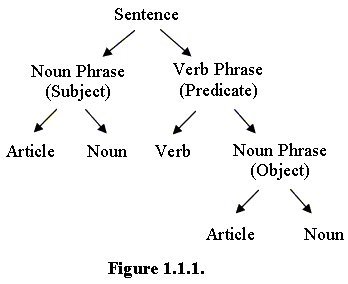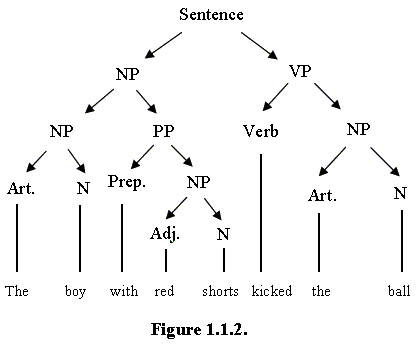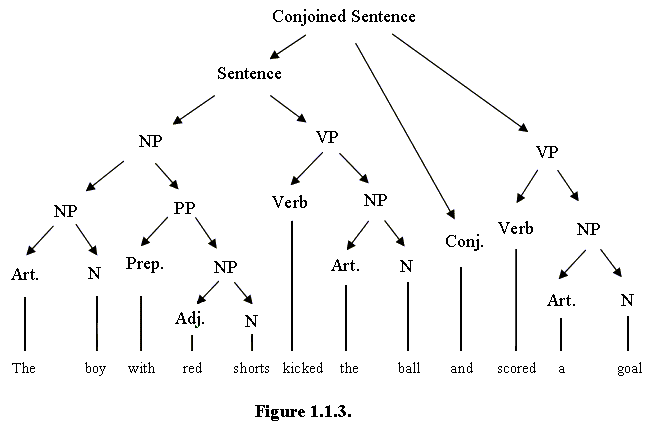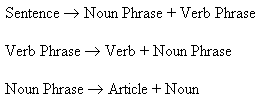
CHAPTER 1 - Additional Notes
The Role of Syntax in Language
This section is an introduction to syntax in language as far as it is relevant to the content of this book. It is not meant to be a rigorous discussion of linguistics. What I am describing is a simple orthodox view of the grammar of language. Some more complex models are discussed by linguists but these are beyond the scope of this description. This section is included for those readers who would like a brief overview without having to refer separately to a linguistics textbook. Those who would like to read more about the various linguistic theories should refer to the bibliography for references to linguistics books and to sites on the web covering linguistic topics.
Languages have rules. The rules of a language are called the grammar. The reason for these rules is that a person needs to be able to speak an indeterminately large number of sentences in a lifetime. The effort would be impossibly great if each sentence had to be learnt separately.
By learning the rules for connecting words it is possible to create an infinite number of sentences, all of which are meaningful to a person who knows the syntax. Thus it is possible to construct many sentences that the speaker has never heard before.
A finite number of rules facilitates an infinite number of sentences that can be simultaneously understood by both the speaker and the listener.
In order for this to work with any degree of success, the rules have to be precise and have to be consistently adhered to. These rules cover such things as: the way words are constructed; the way the endings of words are changed according to context (inflection); the classification of words into parts of speech (nouns, verbs, pronouns, etc.); the way parts of speech are connected together.
The rules of grammar do not have to be explicitly understood by the speaker of the language or the listener.
The majority of native speakers of a language will have no formal knowledge of the grammar of a language but are still capable of speaking the language grammatically to a great degree of accuracy. Native speakers of a language assimilate these rules subconsciously while the language is being learned as a child.
The Components of Grammars
The grammar of a language has several components. These can be described as follows:
a) The phonetics that governs the structure of sounds;
b) The morphology that governs the structure of words;
c) The syntax, which governs the structure of sentences
d) The semantics that governs the meanings of words and sentences.
We are concerned here primarily with the syntax of the structure of sentences.
The Representations of Syntax
In Linguistics, the syntax of sentences can be described by different methods, for instance, for the following sentence:
"The boy kicked the ball"
The syntax can be described, by the following methods:
1. A statement of the correct sequence of the parts of speech (or Syntactic Categories):
Subject is followed by verb is followed by object.
In the above example,
subject = "The boy" (article followed by noun)
verb = "kicked"
object = "The ball" (article followed by noun)
2. by a series of transformational rules
For example:
Where in the above example,
3. By parsing diagrams
Here, the parts of a sentence are shown in a graphical way that emphasises the hierarchical relationships between the components of a sentence. For example:
.
Where:
Subject = “the boy” (article + noun)
Verb = “kicked”
Object = “the ball” (article + noun)
The above structure is the basic syntactic structure for a sentence in the English language. As more complex sentences are considered, it is easy, by this method, to see how these different structures relate to each other, by further breaking down the branches of the structure. The syntax of the language contains the rules which govern the structure of phrases and how these can be joined together. The structures and associated rules vary from one language to another.
Parsing diagrams are capable of representing not just one particular language’s grammar but are capable of representing any kind of grammar. For instance, they can be used to represent the rules of invented languages such as computer programming languages.
This method of representation is the one that I will use to represent musical structures because of the graphic nature of the representation and the flexibility of the approach. By this method, we can show the types of syntactic structures in music and show how they relate to each other by expending or contracting branches of the structure.
Examples of More Complex Syntactic Structures in language
1. Embedding
It is possible to construct sentences which are more complex than the example above. This is done by embedding further phrases within the basic structure. For example, in the sentence:
"The boy with red shorts kicked the ball."
"with red shorts" is a prepositional phrase that further describes “the boy” .
This can be represented, within the basic sentence structure, as follows:
.
Here we can see how the Prepositional Phrase (PP) “with red shorts” is embedded within the subject Noun Phrase (NP) so that the subject is subdivided into a Noun Phrase and Prepositional Phrase (PP). The Prepositional Phrase itself contains a further Noun Phrase. The parsing diagram clearly shows the hierarchical relationship between the sentence and its components. There are many other ways of extending this structure by embedding subordinate phrases at different parts of the basic structure.
2. Conjoining.
It is also possible to extend sentences by joining together complete structures or complete and incomplete structures, for example:
"The boy with red shorts kicked the ball and scored a goal"
The conjunction “and” joins together the complete sentence:
"The boy with red shorts kicked the ball"
and the verb phrase:
“scored a goal"
This could be represented as follows:

We will see later that in music there is also one basic structure that can be extended by embedding and conjoining in similar ways.
Return to Chapter 6



